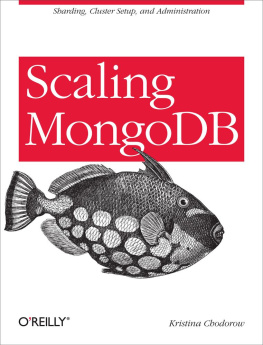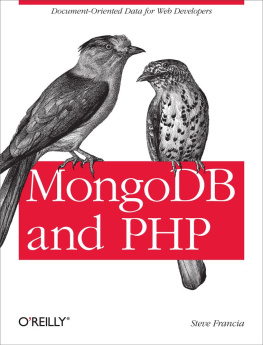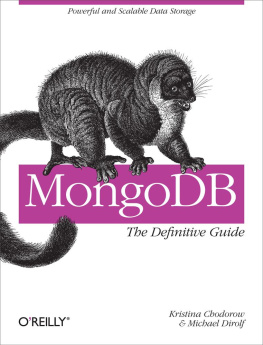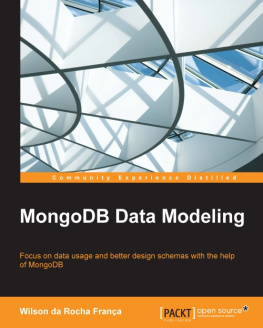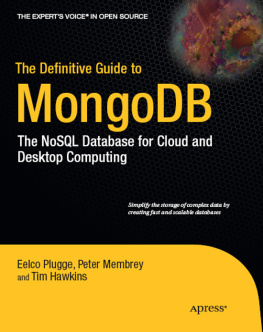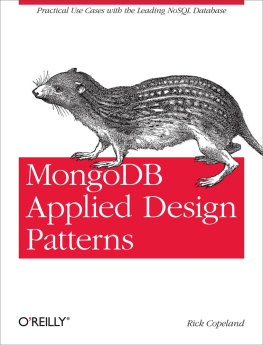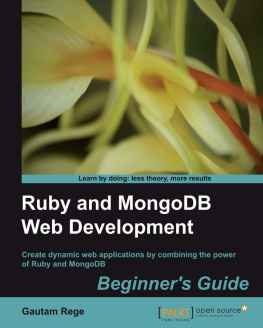MongoDB and Python
Niall OHiggins
Beijing Cambridge Farnham Kln Sebastopol Tokyo
A Note Regarding Supplemental Files
Supplemental files and examples for this book can be found at http://examples.oreilly.com/0636920021513/. Please use a standard desktop web browser to access these files, as they may not be accessible from all ereader devices.
All code files or examples referenced in the book will be available online. For physical books that ship with an accompanying disc, whenever possible, weve posted all CD/DVD content. Note that while we provide as much of the media content as we are able via free download, we are sometimes limited by licensing restrictions. Please direct any questions or concerns to .
Preface
Ive been building production database-driven applications for about 10 years. Ive worked with most of the usual relational databases (MSSQL Server, MySQL, PostgreSQL) and with some very interesting nonrelational databases (Freebase.coms Graphd/MQL, Berkeley DB, MongoDB). MongoDB is at this point the system I enjoy working with the most, and choose for most projects. It sits somewhere at a crossroads between the performance and pragmatism of a relational system and the flexibility and expressiveness of a semantic web database. It has been central to my success in building some quite complicated systems in a short period of time.
I hope that after reading this book you will find MongoDB to be a pleasant database to work with, and one which doesnt get in the way between you and the application you wish to build.
Conventions Used in This Book
The following typographical conventions are used in this book:
Italic
Indicates new terms, URLs, email addresses, filenames, and file extensions.
Constant widthUsed for program listings, as well as within paragraphs to refer to program elements such as variable or function names, databases, data types, environment variables, statements, and keywords.
Constant width boldShows commands or other text that should be typed literally by the user.
Constant width italicShows text that should be replaced with user-supplied values or by values determined by context.
Tip
This icon signifies a tip, suggestion, or general note.
Caution
This icon indicates a warning or caution.
Using Code Examples
This book is here to help you get your job done. In general, you may use the code in this book in your programs and documentation. You do not need to contact us for permission unless youre reproducing a significant portion of the code. For example, writing a program that uses several chunks of code from this book does not require permission. Selling or distributing a CD-ROM of examples from OReilly books does require permission. Answering a question by citing this book and quoting example code does not require permission. Incorporating a significant amount of example code from this book into your products documentation does require permission.
We appreciate, but do not require, attribution. An attribution usually includes the title, author, publisher, and ISBN. For example: MongoDB and Python by Niall OHiggins. Copyright 2011 OReilly Media Inc., 978-1-449-31037-0.
If you feel your use of code examples falls outside fair use or the permission given above, feel free to contact us at .
Safari Books Online
Note
Safari Books Online is an on-demand digital library that lets you easily search over 7,500 technology and creative reference books and videos to find the answers you need quickly.
With a subscription, you can read any page and watch any video from our library online. Read books on your cell phone and mobile devices. Access new titles before they are available for print, and get exclusive access to manuscripts in development and post feedback for the authors. Copy and paste code samples, organize your favorites, download chapters, bookmark key sections, create notes, print out pages, and benefit from tons of other time-saving features.
OReilly Media has uploaded this book to the Safari Books Online service. To have full digital access to this book and others on similar topics from OReilly and other publishers, sign up for free at http://my.safaribooksonline.com.
How to Contact Us
Please address comments and questions concerning this book to the publisher:
| OReilly Media, Inc. |
| 1005 Gravenstein Highway North |
| Sebastopol, CA 95472 |
| 800-998-9938 (in the United States or Canada) |
| 707-829-0515 (international or local) |
| 707-829-0104 (fax) |
We have a web page for this book, where we list errata, examples, and any additional information. You can access this page at:
| http://www.oreilly.com/catalog/0636920021513 |
To comment or ask technical questions about this book, send email to:
For more information about our books, courses, conferences, and news, see our website at http://www.oreilly.com.
Find us on Facebook: http://facebook.com/oreilly
Follow us on Twitter: http://twitter.com/oreillymedia
Watch us on YouTube: http://www.youtube.com/oreillymedia
Acknowledgments
I would like to thank Ariel Backenroth, Aseem Mohanty and Eugene Ciurana for giving detailed feedback on the first draft of this book. I would also like to thank the OReilly team for making it a great pleasure to write the book. Of course, thanks to all the people at 10gen without whom MongoDB would not exist and this book would not have been possible.
Chapter 1. Getting Started
Introduction
First released in 2009, MongoDB is relatively new on the database scene compared to contemporary giants like Oracle which trace their first releases to the 1970s. As a document-oriented database generally grouped into the NoSQL category, it stands out among distributed key value stores, Amazon Dynamo clones and Google BigTable reimplementations. With a focus on rich operator support and high performance Online Transaction Processing (OLTP), MongoDB is in many ways closer to MySQL than to batch-oriented databases like HBase.
The key differences between MongoDBs document-oriented approach and a traditional relational database are:
MongoDB does not support joins.
MongoDB does not support transactions. It does have some support for atomic operations, however.
MongoDB schemas are flexible. Not all documents in a collection must adhere to the same schema.
1 and 2 are a direct result of the huge difficulties in making these features scale across a large distributed system while maintaining acceptable performance. They are tradeoffs made in order to allow for horizontal scalability. Although MongoDB lacks joins, it does introduce some alternative capabilites, e.g. embedding, which can be used to solve many of the same data modeling problems as joins. Of course, even if embedding doesnt quite work, you can always perform your join in application code, by making multiple queries.
The lack of transactions can be painful at times, but fortunately MongoDB supports a fairly decent set of atomic operations. From the basic atomic increment and decrement operators to the richer findAndModify, which is essentially an atomic read-modify-write operator.


